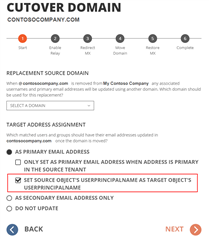Quest is excited to release a new feature within On Demand Migration (ODM) Domain Move that can automatically update a target account’s UserPrincipalName (UPN) at the same time it updates the target account’s Primary SMTP address.
This is a task that many companies previously performed by running a PowerShell script. This new feature automates this step, reducing the overall time and manual effort required for performing a Domain Move.
How do I configure my project to update target UPN values?
When you start the Domain Move wizard and navigate to the screen where you select the target address assignment method, you will see an additional option available to “Set Source Object’s UserPrincipalName as Target Object’s UserPrincipalName”.
If the domain suffix of the source object UPN matches the domain currently being migrated, then the domain suffix of the target object UPN will also be updated when this option is selected.

What else is new in Domain Move?
Option to force domain removal from source tenant
Quest recently added an option to force domain removal from the source tenant in cases where the domain still exists on orphaned objects or objects that are no longer mail-enabled. If source domain removal fails, ODM Domain Move prompts the migration administrator to “Retry this Step”.
In cases where there are orphaned objects, a standard Retry might fail, but the migration administrator can use this new option to have ODM Domain Move “Force Remove Domain”. This option automates the process that a tenant administrator would previously perform manually to force a domain removal using the M365 admin center.

Note: All ODM Domain Move prerequisites are still required. If source domain removal fails due to insufficient permissions, the tenant administrator must manually remove the domain from the tenant using a Global Administrator account.
Further Information
For more information on this and many other features within On Demand Migration, check out the Domain Move Quick Start Guide and the complete On Demand Migration for Active Directory User Guide, and come visit us at Quest.com.

